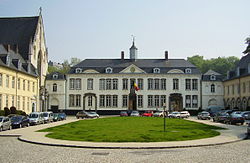| La Cambre Abbey | |
|---|---|
 View from the cour d'honneur (main courtyard) | |
 | |
| General information | |
| Type | Abbey |
| Architectural style | |
| Town or city | City of Brussels, Brussels-Capital Region |
| Country | Belgium |
| Coordinates | 50°49′08″N 4°22′27″E / 50.81889°N 4.37417°E |
| Construction started | 1201 |
| Closed | Deconsecrated in 1796 |
| Designations | Protected (30/06/1953) |
| Website | |
| Official website | |
| References | |
| [1] | |
La Cambre Abbey (French: Abbaye de La Cambre, pronounced [a.be.i d(ə) la kɑ̃bʁ]) or Ter Kameren Abbey (Dutch: Abdij Ter Kameren) is a former Cistercian abbey in the City of Brussels, Belgium. It is located in the Maelbeek valley between the Bois de la Cambre/Ter Kamerenbos and the Ixelles Ponds. The abbey church is a Catholic parish of the Archdiocese of Mechelen–Brussels and home to a community of Norbertine canons, while other parts of the monastery house the headquarters of the Belgian National Geographic Institute (NGI) and La Cambre, a prestigious visual arts school.
The abbey was founded around 1196 and reached its apogee in the 13th century. It was suppressed during the French Revolution and abolished in 1796. Most of today's buildings date from the 18th century; only the church, the refectory and the wing of the capitular hall maintain their medieval character. The simple abbey church houses Albert Bouts' early 16th-century oil painting The Mocking of Christ.
- ^ Région de Bruxelles-Capitale (2016). "Abbaye de la Cambre" (in French). Brussels. Retrieved 1 November 2023.